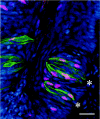Analysis of cell lineage relationships in taste buds
- PMID: 12040059
- PMCID: PMC6758775
- DOI: 10.1523/JNEUROSCI.22-11-04522.2002
Analysis of cell lineage relationships in taste buds
Abstract
Taste buds are a heterogeneous population of cells exhibiting diverse morphological and biochemical characteristics. Because taste buds arise from multiple progenitors, the different types of taste cells may represent distinct lineages. The present study was undertaken to determine the following: (1) how many progenitors contribute to a taste bud, and (2) whether the specific subpopulation of serotonin-immunoreactive (IR) taste cells are related by lineage to a restricted set of progenitor cells. These questions were addressed using cell lineage analysis of taste buds from H253 X-inactivation mosaic mice. After random X-inactivation of the lacZ transgene, the tongue of hemizygous female mice displays discrete patches of epithelial cells, which are either beta-galactosidase (beta-gal) positive or beta-gal negative. By analyzing the proportion of the two differently stained cell populations in taste buds located at the boundary between positive and negative epithelial patches, we can determine the minimum number of progenitors that may contribute to the formation of a taste bud. The presence of taste buds containing only 6-12% labeled cells indicates that at least eight progenitors contribute to an average taste bud of 55 cells, assuming progenitors contribute equally to the cell population. Cell lineage analysis of serotonin-IR taste cells in such mixed taste buds suggests that this subpopulation likely arises from only one to two progenitors and often is related by lineage. Thus, at least some of the cell types in a taste bud represent distinct lineages of cells and are not merely phenotypic stages as a cell progresses from a young to a mature state.
Figures





Similar articles
-
Cell lineage mapping of taste bud cells and keratinocytes in the mouse tongue and soft palate.Stem Cells. 2009 Feb;27(2):442-50. doi: 10.1634/stemcells.2008-0611. Stem Cells. 2009. PMID: 19038788 Free PMC article.
-
Taste receptor cells arise from local epithelium, not neurogenic ectoderm.Proc Natl Acad Sci U S A. 1995 Mar 14;92(6):1916-20. doi: 10.1073/pnas.92.6.1916. Proc Natl Acad Sci U S A. 1995. PMID: 7892199 Free PMC article.
-
Early taste buds are from Shh+ epithelial cells of tongue primordium in distinction from mature taste bud cells which arise from surrounding tissue compartments.Biochem Biophys Res Commun. 2019 Jul 12;515(1):149-155. doi: 10.1016/j.bbrc.2019.05.132. Epub 2019 May 24. Biochem Biophys Res Commun. 2019. PMID: 31133375 Free PMC article.
-
Cell lineage and differentiation in taste buds.Arch Histol Cytol. 2006 Dec;69(4):209-25. doi: 10.1679/aohc.69.209. Arch Histol Cytol. 2006. PMID: 17287576 Review.
-
In vivo fate tracing studies of mammalian taste cell progenitors.Ann N Y Acad Sci. 2009 Jul;1170:34-8. doi: 10.1111/j.1749-6632.2009.04371.x. Ann N Y Acad Sci. 2009. PMID: 19686103 Free PMC article. Review.
Cited by
-
Morphological and Immunopathological Aspects of Lingual Tissues in COVID-19.Cells. 2022 Apr 6;11(7):1248. doi: 10.3390/cells11071248. Cells. 2022. PMID: 35406811 Free PMC article.
-
Culture of endodermal stem/progenitor cells of the mouse tongue.In Vitro Cell Dev Biol Anim. 2009 Jan-Feb;45(1-2):44-54. doi: 10.1007/s11626-008-9149-2. Epub 2008 Oct 2. In Vitro Cell Dev Biol Anim. 2009. PMID: 18830772
-
Mash1-expressing cells could differentiate to type III cells in adult mouse taste buds.Anat Sci Int. 2018 Sep;93(4):422-429. doi: 10.1007/s12565-018-0431-4. Epub 2018 Mar 10. Anat Sci Int. 2018. PMID: 29525940
-
NTPDase2+ Cells Generate Lingual Epithelia and Papillae.Front Genet. 2012 Nov 27;3:255. doi: 10.3389/fgene.2012.00255. eCollection 2012. Front Genet. 2012. PMID: 23293651 Free PMC article.
-
Vasoactive intestinal peptide-null mice demonstrate enhanced sweet taste preference, dysglycemia, and reduced taste bud leptin receptor expression.Diabetes. 2010 May;59(5):1143-52. doi: 10.2337/db09-0807. Epub 2010 Feb 11. Diabetes. 2010. PMID: 20150284 Free PMC article.
References
-
- Barlow LA, Northcutt RG. Embryonic origin of amphibian taste buds. Dev Biol. 1995;169:273–285. - PubMed
-
- Barrandon Y, Green H. Cell migration is essential for sustained growth of keratinocyte colonies: the roles of transforming growth factor-alpha and epidermal growth factor. Cell. 1987;50:1131–1137. - PubMed
-
- Conger AD, Wells MA. Radiation and aging effect on taste structure and function. Radiat Res. 1969;37:31–49. - PubMed
-
- Delay RJ, Kinnamon JC, Roper SD. Ultrastructure of mouse vallate taste buds. II. Cell types and cell lineage. J Comp Neurol. 1986;253:242–252. - PubMed
Publication types
MeSH terms
Substances
Grants and funding
LinkOut - more resources
Full Text Sources
Medical
